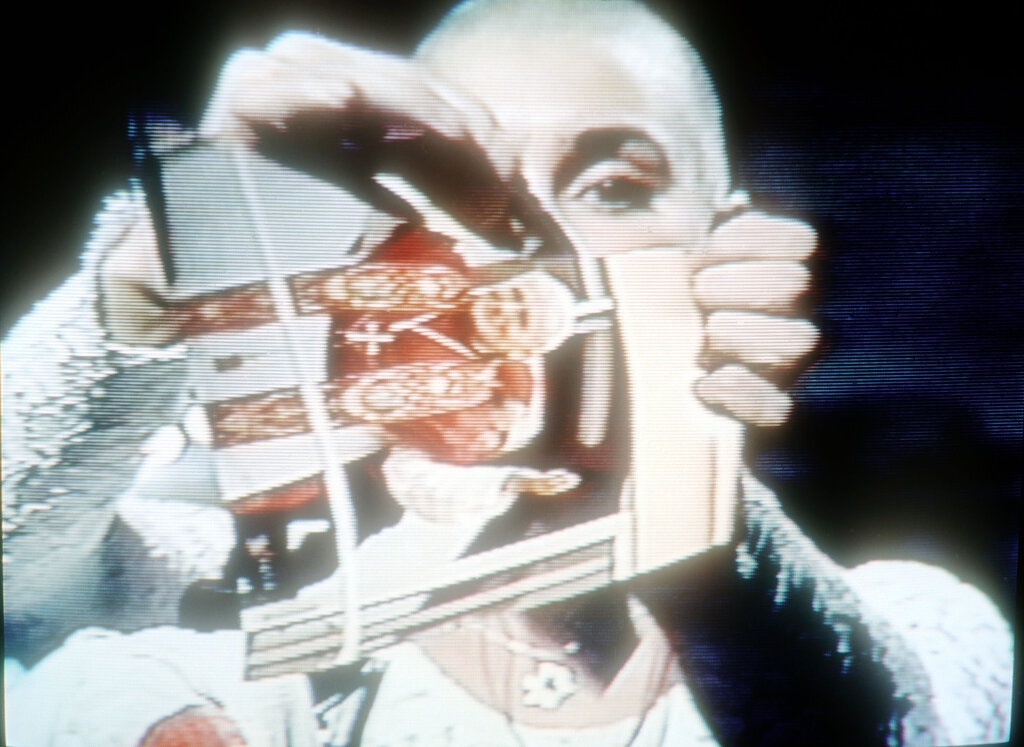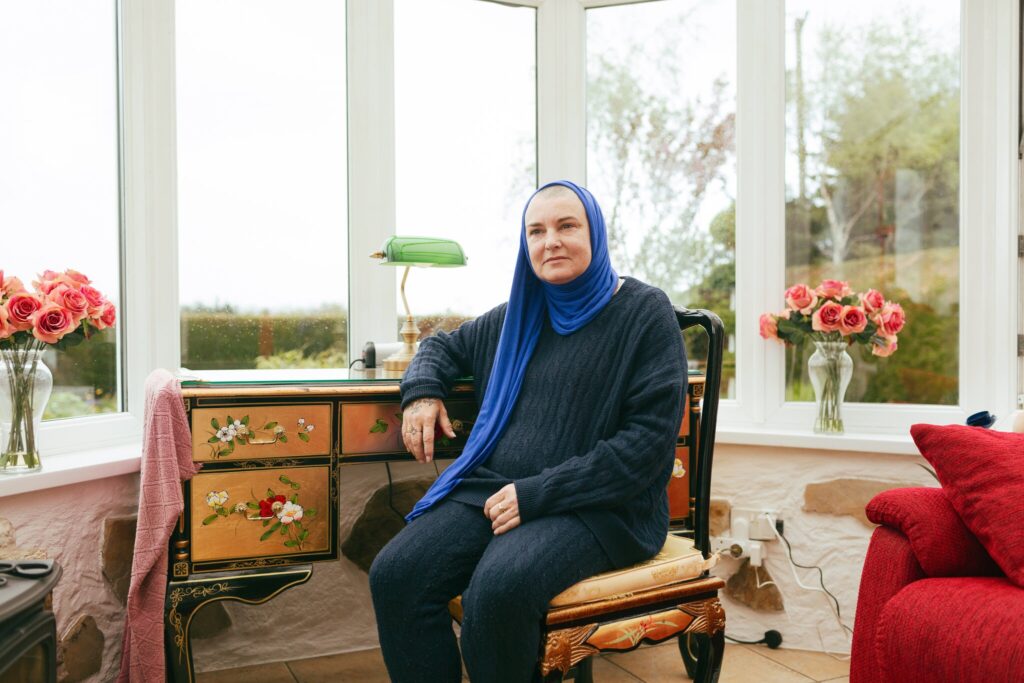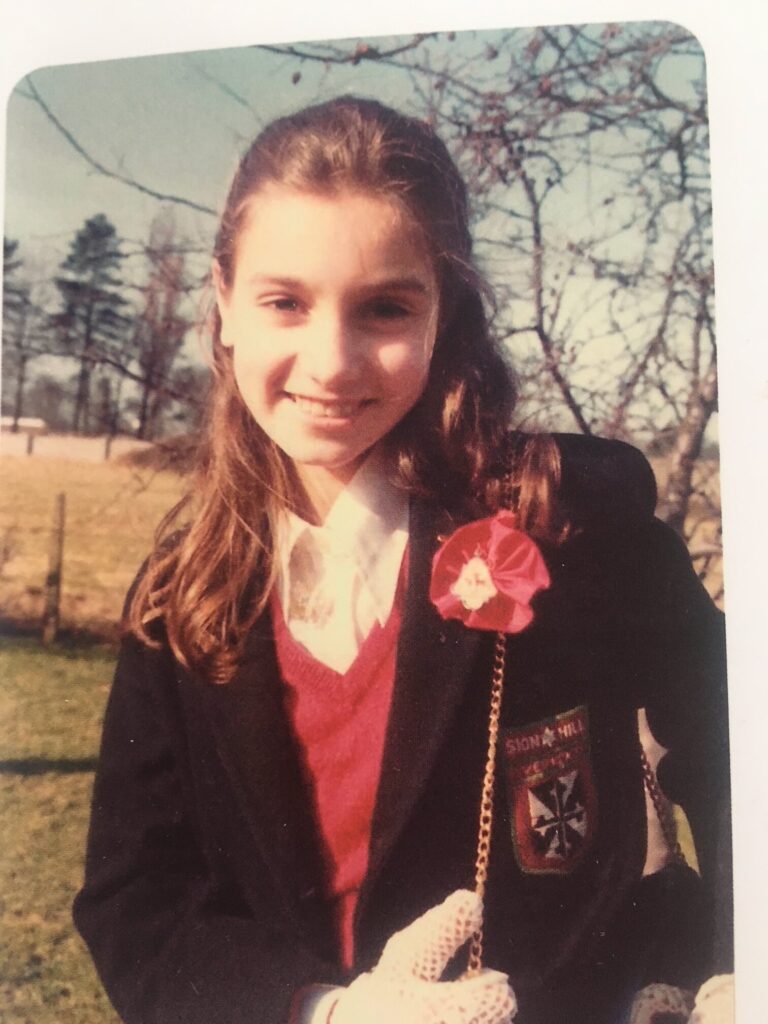(IRELAND)
New York Times [New York NY]
May 18, 2021
By Amanda Hess
The mainstream narrative is that a pop star ripped up a photo of the pope on “Saturday Night Live” and derailed her life. What if the opposite were true?
Sinead O’Connor is alone, which is how she prefers to be. She has been riding out the pandemic in a tiny village on an Irish mountaintop, watching murder shows, buying fairy-garden trinkets online and mainlining American news on CNN. On a recent overcast afternoon, she had a navy hijab arranged over her shaved head and a cigarette permanently installed between her fingertips, and when she leaned over an iPad inside her all-glass conservatory, she looked as if she had been hermetically sealed into her own little world.
“I’m lucky,” she said, “because I enjoy my own company.”
Her cottage was appointed in bright, saturated colors that leapt out from the monotonous backdrop of the Irish sky with the surreal quality of a pop-up book. Bubble-gum roses lined the windows, and the Hindu goddess Durga stretched her eight arms across a blanket on a cozy cherry couch. When O’Connor, 54, gave me a little iPad tour during our video interview, the place seemed to fold in on itself: The flowers were fake ones she bought on Amazon.com, and her pair of handsome velvet chairs weren’t made for sitting.
“Deliberately, I bought uncomfortable chairs, because I don’t like people staying long,” she said. “I like being on my own.” But she disclosed this with such an impish giggle that it sounded almost like an invitation.
O’Connor is, no matter how hard she tries to fight it, irresistible. She exudes a tender familiarity, thanks to her cherubic smile, her loose tongue and the fact that she happens to possess one of the most iconic heads in pop culture memory. In the early ’90s, O’Connor became so famous that the very dimensions of her skull seemed inscribed in the public consciousness. If you remember two things about her, it’s that she vaulted to fame with that enduring close-up in the video for her version of “Nothing Compares 2 U” — and then, that she stared down a “Saturday Night Live” camera, tore up a photo of Pope John Paul II and killed her career.

But O’Connor doesn’t see it that way. In fact, the opposite feels true. Now she has written a memoir, “Rememberings,” that recasts the story from her perspective. “I feel that having a No. 1 record derailed my career,” she writes, “and my tearing the photo put me back on the right track.”
O’Connor saw herself as a protest-singing punk. When she ascended to the top of the pop charts, she was trapped. “The media was making me out to be crazy because I wasn’t acting like a pop star was supposed to act,” she told me. “It seems to me that being a pop star is almost like being in a type of prison. You have to be a good girl.” And that’s just not Sinead O’Connor.
“CRAZY” IS A wordthat does some dirty cultural work. It is a flip way of referencing mental illness, yes. But it’s also a slippery label that has little to do with how a person’s brain works and everything to do with how she is culturally received. Calling someone crazy is the ultimate silencing technique. It robs a person of her very subjectivity.
By the time O’Connor appeared on “S.N.L.,” in October 1992, she had already been branded as insane — for boycotting the Grammy Awards where she was up for record of the year (they recognized only “material gain,” she said) and refusing to play “The Star-Spangled Banner” before her concerts (because national anthems “have nothing to do with music in general”). But now her reputation felt at permanent risk.
“I’m not sorry I did it. It was brilliant,” she said of her protest against abuse in the Catholic Church. “But it was very traumatizing,” she added. “It was open season on treating me like a crazy bitch.”
Soon after the show, O’Connor appeared at a Bob Dylan tribute concert, and when the crowd booed, she was so taken aback she thought, at first, that they were making fun of her outfit. Joe Pesci threatened to smack her in an “S.N.L.” monologue, and later, on that same stage, Madonna mocked her in a gently condescending fashion, play-scowling and ripping up a photograph of the tabloid-star sex offender Joey Buttafuoco. O’Connor was condemned by the Anti-Defamation League and a group called the National Ethnic Coalition of Organizations, which hired a steamroller to crush hundreds of her albums outside of her record company’s headquarters. The Washington Times named her “the face of pure hatred” and Frank Sinatra called her “one stupid broad.”
Now O’Connor’s memoir arrives at a time when the culture seems eager to reassess these old judgments. The top comment on a YouTube rip of O’Connor’s “Behind the Music” episode is: “Can we all just say she was right!” Few cultural castaways have been more vindicated by the passage of time: child sexual abuse, and its cover-up within the Catholic Church, is no longer an open secret. John Paul II finally acknowledged the church’s role in 2001, nearly a decade after O’Connor’s act of defiance.
But the overreaction to O’Connor was not just about whether she was right or wrong; it was about the kinds of provocations we accept from women in music. “Not because I was famous or anything, but because I was a human being, I had a right to put my hand up and say what I felt,” O’Connor said. Some artists are skilled at shocking in a way designed to sell more records, and others at tempering their political rage into palatable music, but “Sinead is not the tempering type,” her friend Bob Geldof, the musician and activist, told me. “In that, she is very much an Irish woman.”

To understand why O’Connor may have seen her cultural blacklisting as liberating, you have to understand just how deeply she was misapprehended throughout her career. She was still a teenager when she started work on her fierce, ethereal first record, “The Lion and the Cobra,” when an executive — “a square unto high heaven” — called her to lunch and told her to dress more femininely and grow out her close-cropped hair. So she marched to a barber and shaved it all off. “I looked like an alien,” she writes in the book, which was a kind of escape hatch from looking like a human woman. When O’Connor became pregnant in the midst of recording, she writes that the executive called a doctor and tried to coerce her into having an abortion, which she refused. Her first son, Jake, arrived just before the album did.
Later, when “Nothing Compares 2 U” made her a star, O’Connor said the song’s writer, Prince, terrorized her. She had pledged to reveal the details “when I’m an old lady and I write my book,” and now she has: She writes that Prince summoned her to his macabre Hollywood mansion, chastised her for swearing in interviews, harangued his butler to serve her soup though she repeatedly refused it, and sweetly suggested a pillow fight, only to thump her with something hard he’d slipped into his pillowcase. When she escaped on foot in the middle of the night, she writes, he stalked her with his car, leapt out and chased her around the highway.
Prince is the type of artist who is hailed as crazy-in-a-good-way, as in, “You’ve got to be crazy to be a musician,” O’Connor said, “but there’s a difference between being crazy and being a violent abuser of women.” Still, the fact that her best-known song was written by this person does not faze her at all. “As far as I’m concerned,” she said, “it’s my song.”
O’CONNOR’S STATEMENT ON “S.N.L.” was more personal than most knew. In the book, she details how her mother physically abused her throughout her childhood. “I won the prize in kindergarten for being able to curl up into the smallest ball, but my teacher never knew why I could do it so well,” she writes. There is a reason, in the “Nothing Compares 2 U” video, she begins to cry when she hits the line about her mama’s flowers. O’Connor was 18 when her mother died, and on that day, she took down the one photograph on her mom’s bedroom wall: the image of the pope. O’Connor carefully saved the photo, waiting for the right moment to destroy it.
“Child abuse is an identity crisis and fame is an identity crisis, so I went straight from one identity crisis into another,” she said. And when she tried to call attention to child abuse through her fame, she was vilified. “People would say that she’s fragile,” Geldof said. “No, no, no. Many people would have collapsed under the weight of being Sinead O’Connor, had it not been Sinead.”
Instead, O’Connor felt freed. “I could just be me. Do what I love. Be imperfect. Be mad, even,” she writes in the book. “I’m not a pop star. I’m just a troubled soul who needs to scream into mikes now and then.” She sees the backlash as having pushed her away from the wrong life, in mainstream pop, and forced her to make a living performing live, which is where she feels most comfortable as an artist.
“Rememberings” is a document of a difficult life, but it is also deliciously funny, starting with the title. (“As I’ve said, I can’t remember many details because I was constantly stoned,” she writes.) It is loaded with charming stories from the height of her fame. She rejects the Red Hot Chili Peppers singer Anthony Kiedis’s claim that they had a thing (“Only in his mind”) but confirms a fling with Peter Gabriel (to discover the profane term she assigns to their affair, you’ll have to read it).

But the book does not supply a tidy, cheerful sort of vindication. These moments of cultural reassessment can feel like the awarding of a consolation prize; the fallout of past judgments can never truly be reversed. Meanwhile, the same dynamics keep repeating, over and over again. In recent years, O’Connor’s mental health has become grist for the therapy-entertainment complex overseen by the likes of Dr. Drew and Dr. Phil, who thrive on casting illness as drama and converting pain into spectacle.
O’Connor has seen a little bit of herself in women who came after her — in Amy Winehouse and Britney Spears. “What they did to Britney Spears was disgusting,” she said. “If you met a stranger in the street crying, you’d put your arms around her. You wouldn’t start taking photos of her, you know?” It is not lost on O’Connor that the night Spears was roundly categorized as a crazy person, she shaved her hair off. “Why were they saying she’s crazy for shaving her head?” she said. “I’m not.”
O’Connor still shaves her head, herself, about every 10 days. “I just don’t feel like me when I have hair,” she said. She usually wears a hijab over it now; she converted to Islam several years ago and started going by the name Shuhada Sadaqat, though she still answers to O’Connor, too. She wrote the first part of her memoir in 2015, but after having a hysterectomy and “a total breakdown,” as she puts it in the book, it took time for her to revisit the project.
She spent six years in and out of mental health facilities — the book is partly dedicated to the staff and patients atSt. Patrick’s University Hospital — and she now has some clarity about how her mind works: Chiefly, that she has complex post-traumatic stress disorder and borderline personality disorder. Her difficulty remembering the post-“S.N.L.” period is also the product of trauma. “It was a very lonesome, lonesome 10 years,” O’Connor said. “I really trust the subconscious,” she added. “If it doesn’t want you to remember something, there’s a very good reason for that.”
O’CONNOR NEVER UNDERSTOOD why people were so drawn to her music. But a few years ago, she was preparing to head out on tour after a long break from the road, and “I couldn’t remember the bloody lyrics of any of the songs,” she said. For the first time, she browsed the internet for old artifacts from her career. “I was like, Jesus Christ, this is really good,” she said. “That’s me! Oh my God!”
A couple of years ago, the Irish producer David Holmes approached O’Connor, star-struck at an event, and asked if she’d make a record with him about healing. “She is just an incredibly complex individual and she should never be judged,” Holmes told me. “She doesn’t go out of her way to try and hurt anyone. She’s just Sinead, and she wears her heart on her sleeve.” Their seven-track album “No Veteran Dies Alone” is due out later this year.
O’Connor’s ethereal sound has acquired an appealingly raw undercurrent. When she sings, on the title track, “There are two mes, the one that you see/and the real me, who I’m not supposed to be,” her pull is undeniable. As Holmes put it: “She’s got that voice, it’s like a friend.”
O’Connor’s own friends describe her as a naturally loving person. “She’s a generous soul,” the Pogues singer Shane MacGowan told me over email. “She looked after me when I really needed it.” Said her longtime friend Kara Hanahoe, “I’ve just found that she can be relied upon, and I think that’s probably the most important thing.”
O’Connor is a dedicated email correspondent; as I wrote, she sent me emails signed “Sinead / Shuhada,” and punctuated with emojis of sunglasses and cherry blossoms. But her complex post-traumatic stress has translated into agoraphobia, and her life circumstances have not always allowed for people to stay close. Geldof knows friends who won’t speak to O’Connor anymore, but he’s not one of them. “She can say whatever she likes about me and my wife,” he said. “Because it’s her.”
O’Connor is happy being on her own, with her garden and her Mayfair cigarettes and her iPads and her “imaginary boyfriend,” Taye Diggs, to keep her company via episodes of “Murder in the First.” “I haven’t been terribly successful at being a girlfriend or wife,” she said. “I’m a bit of a handful, let’s face it.”
But a few months ago, when she moved into her blissfully remote cottage, she found that several other single women lived alone nearby. Soon a couple of them had come by offering bread and scones, and she found herself with a crew of girlfriends for the first time since she was a teenager. “We bury bodies for each other,” she said.
The trouble of releasing a memoir is that it has forced O’Connor to relive her past, and that can be a traumatic experience, even if it does spur a cultural reckoning. “Down the mountain, as I call it, nobody can forget about Sinead O’Connor,” she said. But up in the village, nobody cares, “which is beautiful for me,” she said. “It’s lovely having friends.”
Amanda Hess is a critic at large for the New York Times. She writes about internet and pop culture for the Arts section and contributes regularly to The New York Times Magazine. @amandahess • Facebook
